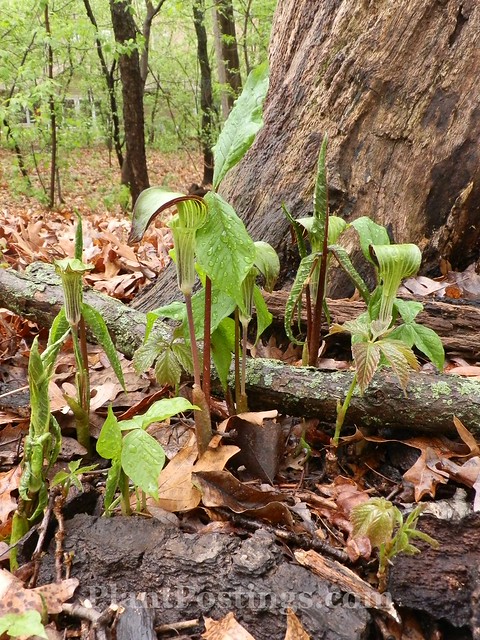
Is it tougher to write a Garden Bloggers' Bloom Day and Foliage Follow-Up post when you don't have much happening in your garden or when there's way too much to cover in one post?
I'm not quite sure how to answer that question, but I do know there's lots of blooming and growing going on in my USDA zone 5 Southern Wisconsin garden lately. Temporarily cooler weather is "holding" some the blooms--a little consolation of still needing a jacket into mid-May.
Here are a few of the highlights:
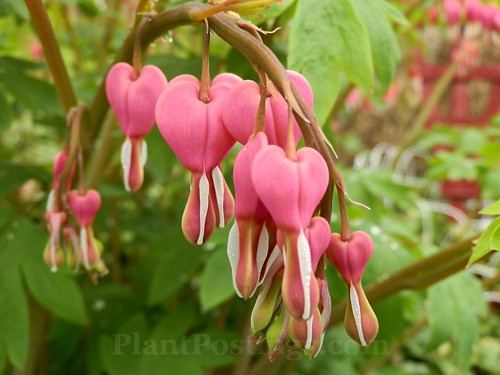
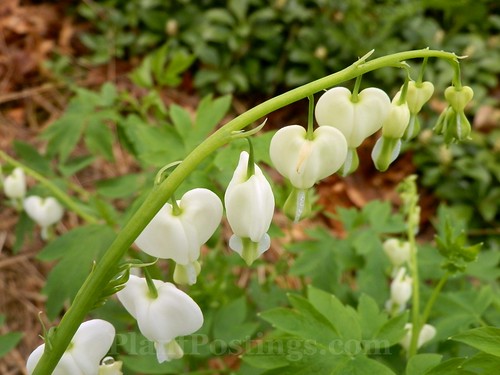
Both the common pink and the 'Alba' Bleeding Hearts (Lamprocapnos spectabilis) seem more plentiful and lush than ever. It's amazing that this fragile-looking plant (among others) can survive and even thrive after the bitter cold winter we had this year. But it is hardy to zone 3.
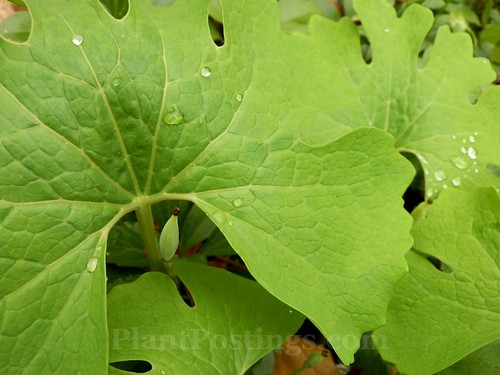
Bloodroot (Sanguinaria canadensis) has finished blooming and the seed pods have formed. I'm watching them closely because I'd like to scatter a few seeds in other parts of the garden.
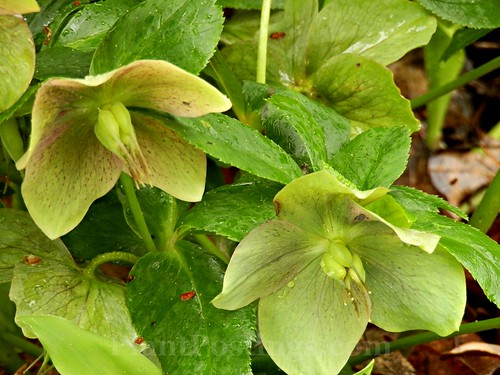
Likewise, the Hellebores (Helleborus orientalis) are forming seed pods. I've never collected the seeds or tried to cross-breed them, but maybe I will someday.
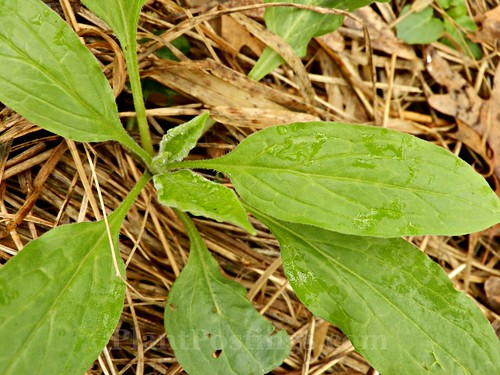
I'm pretty sure this is a Virginia Bluebell (Mertensia virginica), growing where I planted seeds last fall. I've heard it might take a couple of years for them to bloom.
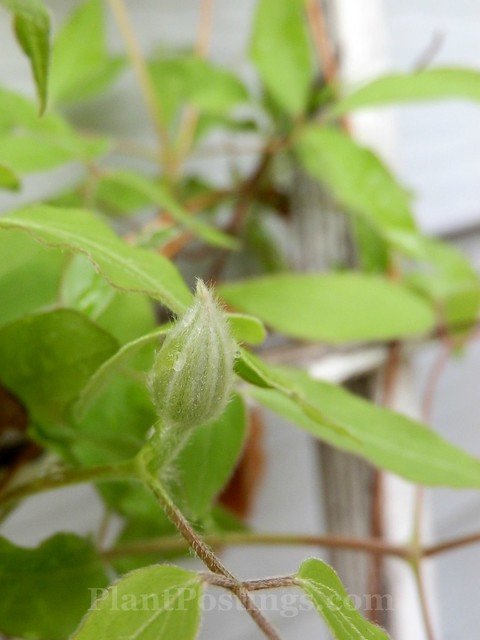
The two Clematis 'Nelly Moser' plants are back again, after I re-established them last spring. The bases are double protected against rabbits.
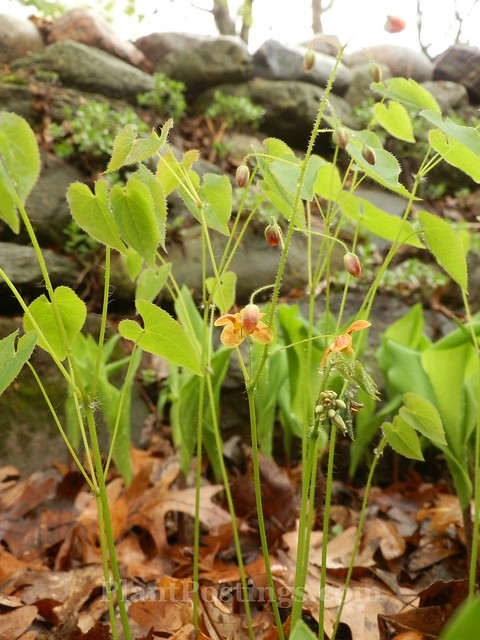
The Barrenworts (Epimedium spp.) that I planted last spring survived, too.
E. x warleyense stayed evergreen all winter--or at least the lower foliage was still green when the snow receded. I was thrilled to see the first blooms and new growth.
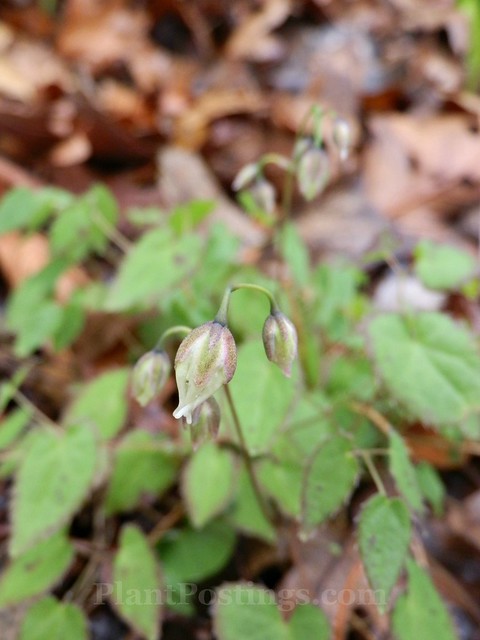
I thought E. 'Creeping Yellow' had died because there was a bare spot in its place ... until new growth emerged. And now it's blooming, too.
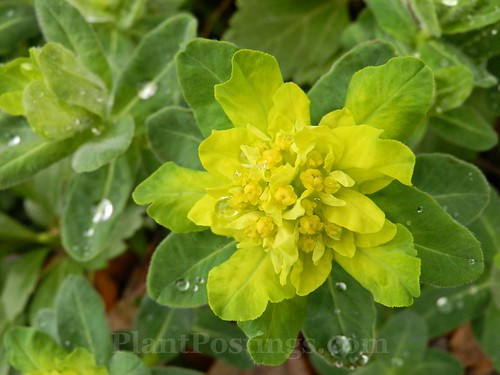
The semi-succulent foliage and bracts of Cushion Spurge (Euphorbia polychroma) are filling up their bright, little spot in the garden.
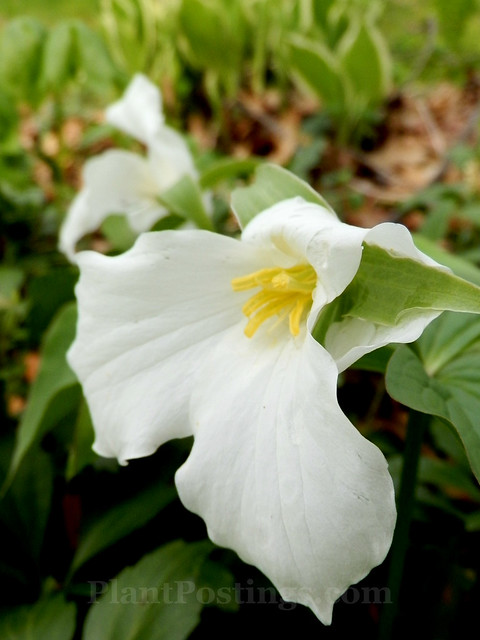
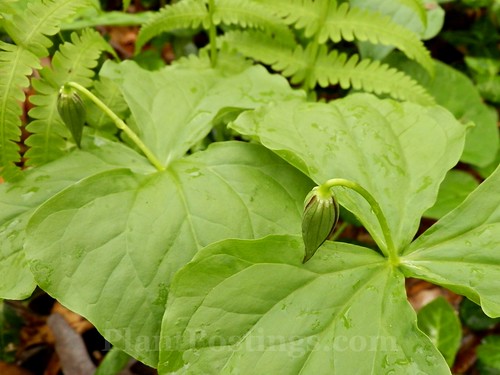
It appears to be a good year for Great White Trilliums (T. grandiflorum) and Red Trilliums (T. erectum), as their numbers have increased this year. We don't have great swaths of them in the garden--they simply dot the landscape amongst the other spring ephemerals, ferns, and ground covers.
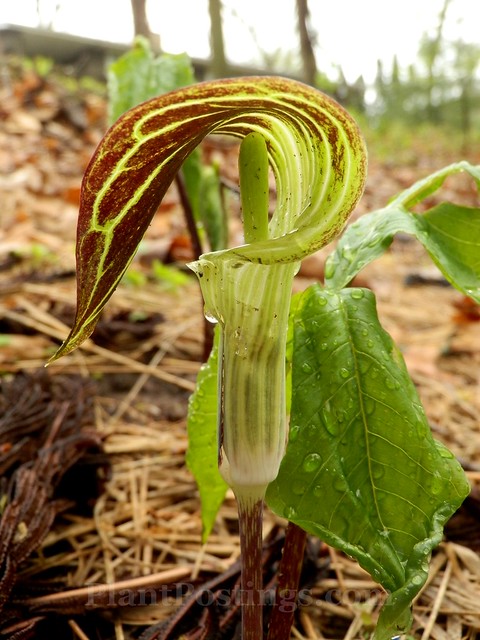
It's also a banner year for Jack-in-the-Pulpit (Arisaema triphyllum). I don't recall seeing this many on the property before. They, too, seem incredibly healthy this year.
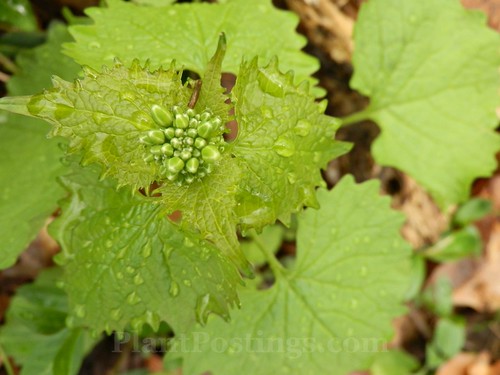
Unfortunately, a banner year for Trilliums and Jacks also seems to be a banner year for Garlic Mustard (Alliaria petiolata), which is extremely invasive in much of North America. We barely had any last year, but we're pulling it like crazy this spring--before it flowers and goes to seed.
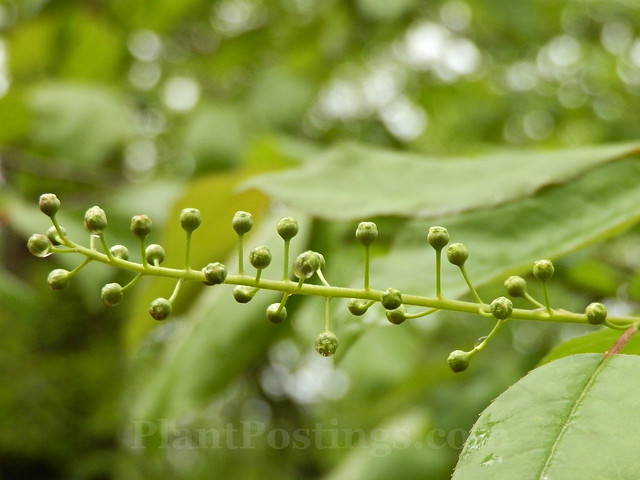
The Chokecherry tree (Prunus virginiana), growing in the shade of our large, old Oak trees, is just about to bloom.
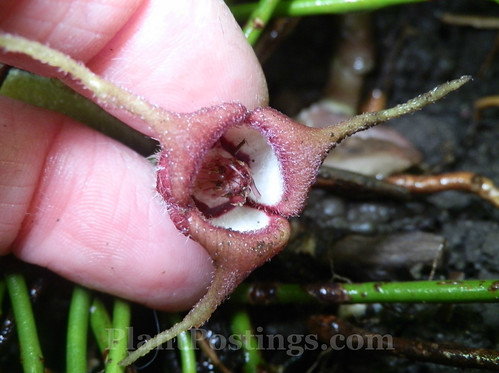
Wild Ginger (Asarum canadense) is filling a bigger swath of the garden, and seems to be gaining ground on some non-native ground covers (yay!). I so enjoy its blooms, which nod close to the ground and hide under the foliage.
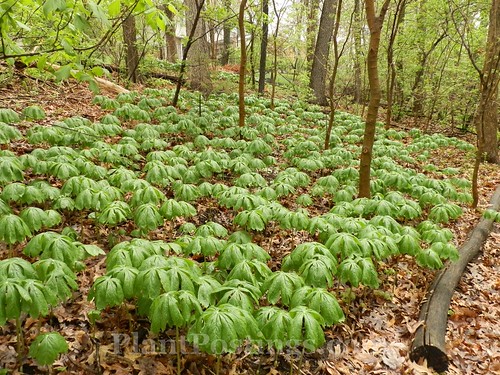
Speaking of swaths, the Mayapples (Podophyllum peltatum) seem happy on their northwest-facing slope of the forest.
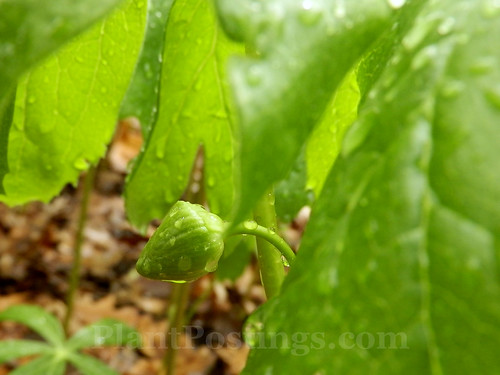
They'll be blooming any day now.
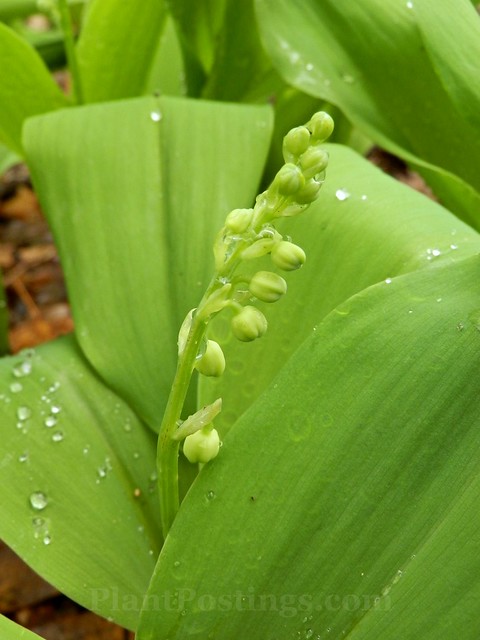
Likewise with Lilies-of-the-Valley (Convallaria majalis), planted in a more cultivated section of the garden.
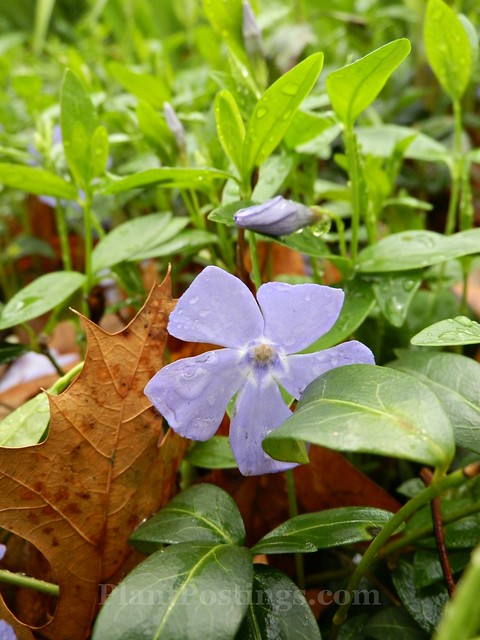
The Vincas (V. minor) are filling their little garden plot with my favorite periwinkle shade of blue.
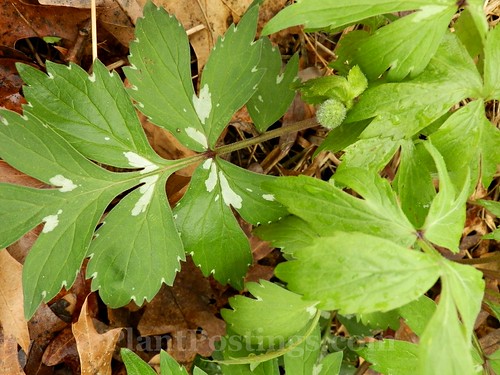
Virginia Waterleaf (Hydrophyllum virginianum) is a little too prolific for my taste. It's native here, but it's taking over a few spots where I'd prefer to see Bluebells and Trilliums. I think I'll transplant some of these.
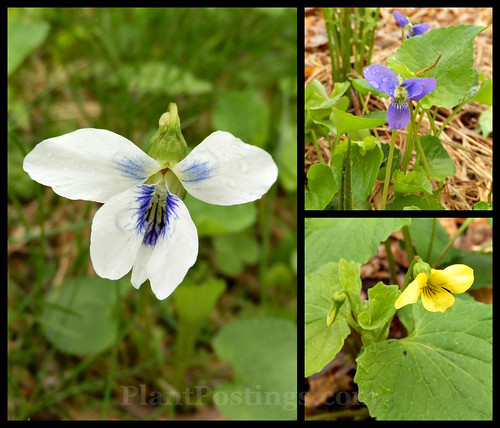
Wild Violets (Viola spp.) are popping up everywhere. I know I'm not supposed to like them in my lawn and garden, but they're mainly concentrated in the "wild" sections. Plus, they're so pretty.
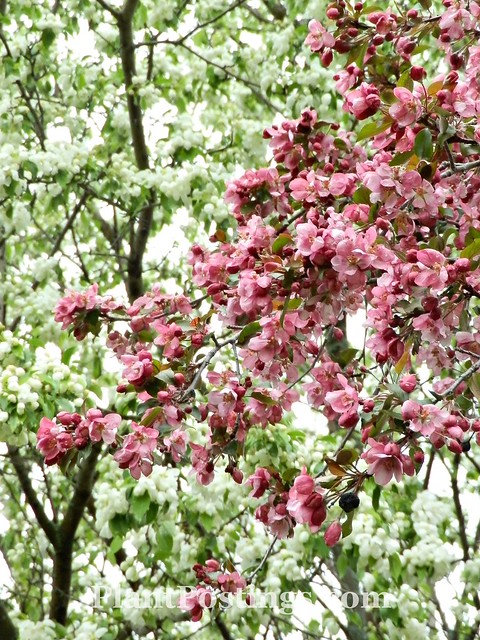
Finally, the Crabapples (Malus spp.) are holding their blooms for record time because of the cool weather. Don't laugh, but I didn't even realize they were blooming the other day until I walked around the corner and caught the scent ... and looked up!
* * * * * * * * * *
Thanks to Carol at May Dreams Gardens for hosting Garden Bloggers' Bloom Day, and Pam at Digging for hosting Foliage Follow-Up. Head on over to their blogs to see what's blooming and growing around the world this May.
Are not those Crab Apples beautiful. Have a great weekend.
ReplyDeleteThey smell wonderful, too! And they're blooming all over town now. Hope you're having a great weekend, too, Karen!
DeleteSome lovely plants! Isn't it so great to have a lot going on in the garden now? I love those little violets that pop up - even in my lawn! They are so pretty.
ReplyDeleteYes, it's wonderful! But it makes it impossible to pick which plants to highlight. I just ran around the garden snapping pictures like a crazy lady. ;-)
DeleteHi Beth! Beautiful post on your about-to-bloom garden! I LOVE the bleeding hearts! I think I'm going to plant a few of them to replace the azaleas I lost this past winter. I also learned a couple of things from your post, one being what Wild Ginger looks like! I have lots of that in my woods and never knew what it was til now! Thank you! Also, thanks for your kind words on my loss of Tyson; that was a veery difficult time for Harry and me.
ReplyDeleteThanks, Diane! Bleeding Hearts are a good bet in northern gardens! And some years--if it doesn't warm up too fast, they can last into the early part of the summer! Good news that you have lots of Wild Ginger--it's a great ground cover plant. So sorry about the loss of your dear pet. I'm sad just thinking about eventually saying goodbye to my cats. Pets really are a part of the family!
DeleteAll are new plants for me. They look so interesting! New lesson for me, again. Thank you for sharing!
ReplyDeleteThanks, Endah. We have much to learn from each other! I feel the same way when I visit your blog!
DeleteI always enjoy your posts. They give me encouragement and some hope. I am also reminded to take my camera with me when I venture in the woods. I have some of what you have in bloom, like vinca, violets, bleeding hearts and trillium. I was thrilled to see your Jack in the Pulpits . . . I wonder how I can get some to grow. 29-30 degrees this morning . . . a reminder . . . it is still spring!
ReplyDeleteThank you, Lynne. Such kind words! Regarding the Jacks: We always have some every year, and generally let them pop up in the "wild" part of the garden wherever they choose to grow. And we let them go to seed in the summer/fall. I'm not sure what the trick is because I just let them grow--they must like deciduous forests with lots of leaf mulch and thick, silt/loam top soil? That's just a guess...
DeleteYour plants look so healthy and real happy! That Arisaema and that wild ginger are so unique, and beautiful. In alittle while your forest floor is teeming with colorful growths. It is amazing how you temperate country people wants to hasten the growth and blooming of your plants, while we us here are so worried because ours dehisce so fast no matter how we want them still.
ReplyDeleteYes, it's amazing how fast everything comes to life here. We're definitely on "fast forward" now. Actually, I prefer if it doesn't get too hot too fast because, as you say, the plants fade away faster then. We're having "perfect" weather now. Everything's blooming and the temperatures are warming up just a bit every day. No complaints here. ;-)
DeleteGreat post! I wish I had those mayapples and jack in the pulpits. I've tried to grow the jacks, but they always ended up infected with rust.
ReplyDeleteThanks, Jason! As I mentioned to Lynne, I have no idea what the secret is on the Jacks (or the Mayapples). They simply grow like crazy here, and I can't take any credit because I simply enjoy them. I was a little worried about the Mayapples because our neighbor (near the Mayapple patch) cut down some trees last fall and I thought maybe the Mayapples wouldn't like the change in light conditions. But they still seem happy, so I'm happy. :)
DeleteOh my gosh Beth, your photographs of the bleeding heart (s) are National Geo quality, really they are exquisite. It's "ordinary" (if we can call anything we love ordinary), but your photographs make them amazing. Also close up of the wild ginger! I love that groundcover and I can only imagine you lying flat on your belly in order to get that shot-:))
ReplyDeleteAwww, thanks Susie! I had to chuckle at your mention of lying flat to capture the Wild Ginger. That happens a lot with garden bloggers, doesn't it. ;-) I really appreciate the Wild Ginger, too. It's fun to find the shy, unique flowers. And the plant is a great ground cover as you mention!!
DeleteI've always loved Bleeding Hearts although I have to plant them as annuals in my garden. They remind me of little charm bracelets. A woodland garden always seems so tranquil, and I have enjoyed seeing your pretty spring plants!
ReplyDeleteBoth types of Bleeding Hearts--Lamprocapnos and Fuchsias--amaze me. It seems like they're almost fake and hard to believe that they grow naturally in nature. I realize that some are hybrids, but even the original, true species plants are incredible! Thanks, Dorothy!
DeleteYour Violets are beautiful. I've never seen yellow ones....what a treat for the eyes! I'm trying to be more "green" in my flowerbed and conscious of what is good for local butterflies.I learned that Violets are essential larval food for Frittillaries.......one more reason to appreciate their cute little faces!
ReplyDeleteGood point! We use Corn gluten meal on our lawn as an organic, pre-emergent treatment. It keeps the Violets at bay in the front yard, but we let the back garden stay more "wild," so the Violets of all colors are all over the place. I really don't mind them, but I know some of the neighbors prefer tidier lawns.
DeleteThe Jack in the Pulpits are so intriguing! I have the cute little related but not spectacular Mouse Plants. I have a lot of wild Pacific Waterleaf coming up in my woods, but don't have any wild bluebells for them to compete with, so I like them as a ground cover. The Mayapples look amazing in a big group. I just planted wild Ginger so I hope it will naturalize.
ReplyDeleteOh, I enjoy the Mouse Plants, too! I didn't know much about them until I saw them on a couple of blogs a while back. The Waterleaf is interesting. But it seems like a bit of a bully. I think I'll transplant it to an area where I want to slowly get rid of other non-native ground covers. Mayapples and Wild Ginger are great native ground covers, too. I hope the Ginger naturalizes for you, too!
DeleteWhat a fantastic collection of ephemerals and wildflowers you have! All those mayapples--wow! Did you plant them or were they already there? It's been a good year here, too, for the garlic mustard; I keep finding it in places I've never seen it before. I just bought some wild ginger this year for the first time--I hope it does well and takes over some of the invasives, as yours has done. Don't you wish we could hold on to spring a while longer?
ReplyDeleteThanks, Rose. I can't take any credit because they all grow wild near the edge and in the woods. Same with the Mayapples--they were all here when we moved in! And the more Garlic Mustard we pick, the better chance all the native plants have a chance to grow. Regarding spring--yes, I always say that May and June are amazing months in this part of the world! I'd prefer not to travel at this time of year because I love my own backyard. Not so much in winter, though. ;-)
DeleteLovely to see your plants have survived the hard winter! Lovely photos as always, and seeing your Asarum canadense reminds me that I still have them on my wish list but I haven’t bought any yet – must do so! And I must admit I do struggle with putting together my GBBD post with so much in flower all the time in my garden. I never show everything I have in flower, but my posts are still incredibly long – how can I choose what to show and what to leave out??
ReplyDeleteThanks, Helene. So far, I don't think I lost any perennials. I'm not sure about a few, and some of my seeds didn't come up yet, but it might be too early to tell with those. I envy your plenty, Helene. I think the U.K. must be the perfect place to garden, and it's no wonder it's such a popular hobby (or way of life) there! Gardening is certainly rewarding here, too, but unfortunately the active part of it is squished into seven months. ;-)
Deletesad world, where you cannot take delight in wild violets!
ReplyDeleteI couldn't agree with you more, Diana. I'm a big fan, so I don't mind them scattered about the yard. I think some folks prefer uninterrupted green lawns, but the violets are so pretty. Our front yard is a little tidier--we use an organic, pre-emergent Corn gluten meal, so hopefully the neighbors are OK with a slightly "wilder" back garden. ;-)
DeleteI was standing in the nursery today looking at a row of Malus in flower and boy how tempted was I. I didn't partake and am thinking it's something I may regret. What a wonderful display you have. I can't imagine not noticing they were flowering.
ReplyDeleteGood to know that many have come through the harsh winter you've experienced over there Beth.
I have to say I find it hard to put together a post with so much in bloom. I really need to start editing some out.
I know. ;-0 I'm so embarrassed, but I thought I should be honest in my ignorance. The Crabapples are in the front yard on the side, so I'm usually looking out away from them. And it was funny how I walked around the front...and there they were...blooming and smelling amazing! I actually think it's harder to do the "too much" posts. Although it's more frustrating to do the "nothing blooming" posts. (By the way, you can always go back to the nursery! ;-)
DeleteI am impressed with you Jack-in-the-Pulpit. They really do not flourish here, despite my wishes. But epimedijums do very well here; apparently they are adapted to a variety of climates. I also love wild violets!
ReplyDeleteIt seems everywhere I turn in the woods this spring, I find a Jack-in-the-Pulpit. The more the merrier with that plant! I've wanted to plant Epimediums for years, but finally made the purchase on two of them last spring. I won't plant Epimediums in the woods (since they aren't native here), but they seem appropriate in a cultivated section near the house. Apparently they can survive the extremes--if they can make it through hot summers and polar vortexes!
DeleteThe crabapple picture is just incredible! I picked up some bloodroot at a plant swap today. Does it need all shade? Isn't it an ephemeral? As for the little weed with the pretty foliage? It's garlic mustard! So out it will come tomorrow. Have a great week!
ReplyDeleteThanks, Tammy! I keep catching amazing whiffs of Crabapples every time I walk around the corner of the house--it's heavenly! Yes, Bloodroot is an ephemeral. Some years, the blooms only last for a couple of days! You're going to love it--it's one of the first spring ephemerals to emerge, and it does so in such a fascinating way! Ah, you have Garlic Mustard, too?! Argh. Yes, better to catch it before it takes over your garden! Plus, you can eat it on salads!
DeleteKwiaty z pierwszego zdjęcia są bardzo ciekawe i ładne, a żółtych fiołków jeszcze nie widziałam. Pozdrawiam.
ReplyDeleteFlowers from the first pictures are very interesting and nice, and yellow violets have not yet seen. Yours.
Thanks, Giga. I think we have every color of wild Violet in our lawn this year. Fun to see, although I know some people want to get rid of them because they're so plentiful here. I will simply enjoy them while they last. :)
DeleteThe problem goes from scouring the grounds for something to feature to editing a post down to a manageable size in May and June....but who's complaining? Thanks for sharing your lovelies.
ReplyDeleteYes, agreed. And it all happens so fast, my head is reeling (in a good way)! Thank you, Ricki. Enjoy the beauty of the season!
DeleteThat whole forest floor of May Apples is amazing. I sure wish I could grow them. Your photos are lovely. I just love this time of year.
ReplyDeleteThanks, Grace. I love this time of year, too! The Mayapples are fun. I love to watch them emerge in the early spring, and then they cover that part of the hill. Actually, their numbers seem a bit smaller this year--maybe because the neighbors cut down some trees which might be letting in more light. Oh well, it's still a healthy patch. :)
DeleteHow great to see all your flowers! I'll cheer on the Asarum canadense and hope that it triumphs. The epimediums are lovely as well.
ReplyDeleteI was just looking at the Wild Ginger this morning, and I do believe the patch is quite a bit bigger than in the past. Yay! It seems like every gardener but me has had Epimediums, and I've always wanted at least one. So last year, I went for it. They're in a small garden plot near the house--so there's no worry about them spreading. Love 'em.
DeleteWhat a spring treat, such beautiful plants...and the grove of may apples...sigh. Well all of them sigh, lol. Gorgeous.
ReplyDeleteDo you think that Bleeding heart will throw seeds, and that they might grow into seedlings, I swear I've got something that looks just like a Bleeding Heart growing.
Jen
The Mayapples are a reliable plant here--a mid-spring joy. The Bleeding Hearts do tend to seed and spread a bit, but they're manageable and fabulous. I hope your plant is a Bleeding Heart ... if that is what you want! :)
DeleteHow lucky you are to have such a beautiful woodland garden. The photos are wonderful too.
ReplyDeleteThanks! Yes, I feel very fortunate to have that "secret" garden out back!
DeleteWe were still wearing our coats in mid May in zone 7. I think the only reason I am not wearing them now is that I washed them and put them away. Still in the 40s in the morning but the flowers are holding forever.
ReplyDeleteWow! We've had summer weather lately, although I'm responding to this comment a little late (sorry--some gardening projects kept me away from my computer). Our highs have been in the 70s and 80sF for a couple of weeks now.
Deletehi beth, I can only echo commonweeder - you are so-o-o lucky to have a woodland garden. I think it is my favourite type of garden, distinguished by large drifts of the same thing and lots of green. Divine. The wild ginger flower looks so inviting, if I were an insect I'm sure I'd check it out to help with pollination. (I assume that's why it evolved to look like that?)
ReplyDeleteYes, I feel very fortunate about the woodland garden, and it will be the hardest thing about moving away from here. :( Regarding the Wild Ginger, yes--it's one of those plants that smells like rotten meat, so it attracts flies. It's not very strong, though, so I don't really notice it (but the pollinators, do).
DeleteYou mentioned not seeing so many Jack-in-the Pulpits. I saw quite a few of them in PA. Must be a good year for them. Wonderful images of the garden flowers. Good to see so much in bloom. We are catching up too. The Mayapple was blooming in PA, but not here before I left. I love the large patch of them. They remind me so much of home in PA.
ReplyDeleteWe always have some Jacks, but yes, this year there are so many! The Mayapple fruits are forming now. I've never tasted them, but apparently they're edible. I think they have to be cooked quite a bit, though.
DeleteMmm, Beth, so much to enjoy there, I love the mayapples spread out like that under the trees, for all the world like umbrellas for very small people. It was the crabapple that really caught my eye though, what a glorious sight. If you remember to look up ;-)
ReplyDeleteMayapples are fabulous! The way they emerge out of nowhere, like little umbrellas out of the soil, is incredible. I will miss them when we move. Crabapples are very plentiful all around town here. They're finished blooming now. They smell fabulous, but I wish the blooms would last longer. :(
DeleteIt was a very strange spring for blooms...you were ahead in so many ways in mid-May but I love all your blooms and foliage especially those natives....stunning.
ReplyDeleteThat's so interesting, Donna, because I think you're a zone ahead of me (6?). It's also curious, because we were quite cool for a while, too. During the past few weeks, though, we've had highs in the 70s and 80sF, which is wonderful (in my opinion). :)
Delete